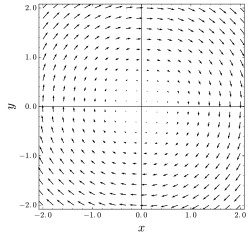Solenoidal vector field

In vector calculus a solenoidal vector field (also known as an incompressible vector field, a divergence-free vector field, or a transverse vector field) is a vector field v with divergence zero at all points in the field:
Properties
The fundamental theorem of vector calculus states that any vector field can be expressed as the sum of an irrotational and a solenoidal field. The condition of zero divergence is satisfied whenever a vector field v has only a vector potential component, because the definition of the vector potential A as:
automatically results in the identity (as can be shown, for example, using Cartesian coordinates):
The converse also holds: for any solenoidal v there exists a vector potential A such that (Strictly speaking, this holds only subject to certain technical conditions on v, see Helmholtz decomposition.)
The divergence theorem gives the equivalent integral definition of a solenoidal field; namely that for any closed surface, the net total flux through the surface must be zero:
-

where is the outward normal to each surface element.
Etymology
Solenoidal has its origin in the Greek word for solenoid, which is σωληνοειδές (sōlēnoeidēs) meaning pipe-shaped, from σωλην (sōlēn) or pipe. In the present context of solenoidal it means constrained as if in a pipe, so with a fixed volume.
Examples
- The magnetic field B (see Maxwell's equations)
- The velocity field of an incompressible fluid flow
- The vorticity field
- The electric field E in neutral regions ( );
- The current density J where the charge density is unvarying, .
- The magnetic vector potential A in Coulomb gauge
See also
References
- Aris, Rutherford (1989), Vectors, tensors, and the basic equations of fluid mechanics, Dover, ISBN 0-486-66110-5